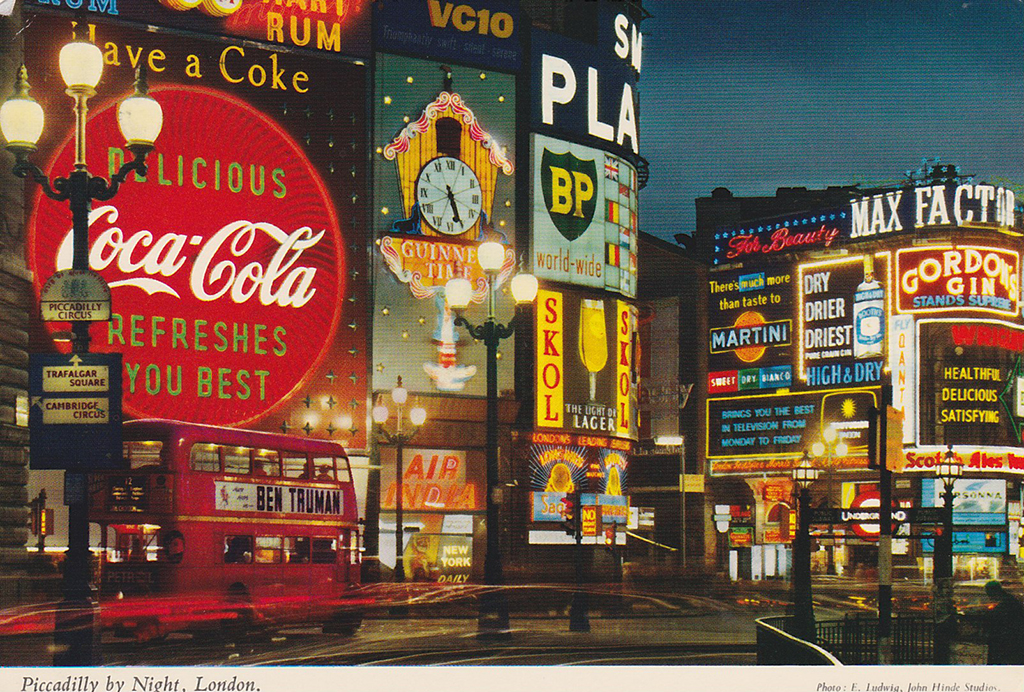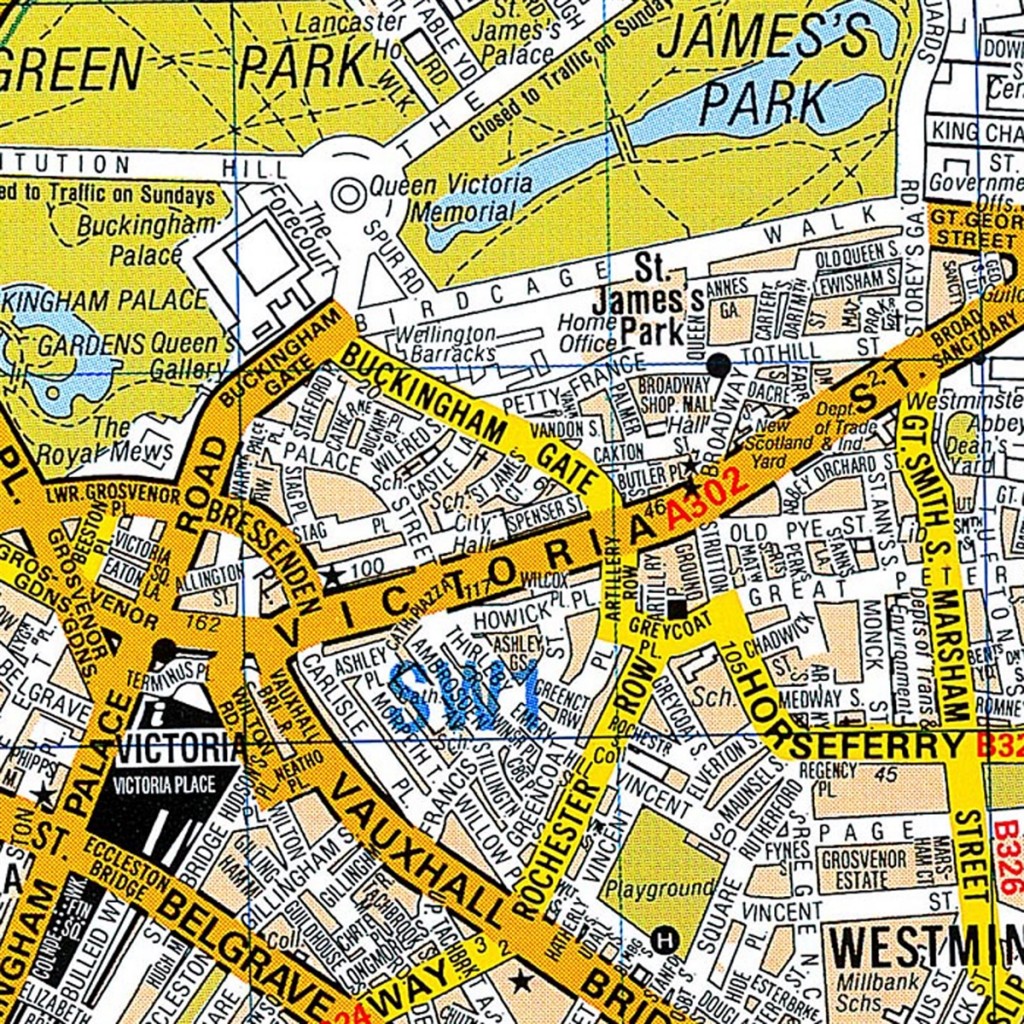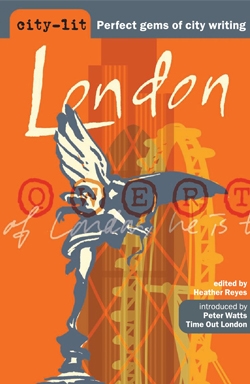Peter Watts is a journalist who has worked in the national media since 1993, starting at The Sunday Times as a 17-year-old sportswriter. He has also been features writer at Time Out, where he edited the Big Smoke section.
Peter now writes about architecture, politics, cinema, drugs, beer, history, music, museums, comedy, football, hippies, archeology, poetry, food, art, tunnels, auctions, buses, books, ghosts and jukeboxes. He also writes about London quite a lot. For more of Peter’s London ramblings you can follow his excellent blog – The Great Wen.
This is an edited extract of an introduction written for City-Lit London, an anthology of London writing, from 2009.
I don’t really know London. This despite having lived and worked within the collar of the M25 for my entire life, something that is simultaneously a source of great pride and creeping shame. I’ve explored it, sure. I’ve gazed down at dawn on drowsy Londoners from atop a thirteenth-century church tower in Hackney. I’ve listened to the hum of traffic passing overhead from deep within the buried Fleet River beneath Holborn Circus. I’ve walked the Thames one Sunday afternoon from St Paul’s to Hampton Court, been to the end of more than half the tube lines, sniffed Billingsgate Market’s early-morning buzz and fed the black-tongued giraffes at London Zoo. I’ve even travelled every bus from 1 to 50 in numerical order, a task that’s taken me to every point of the compass from Debden in the north-east to Fullwell in the south-west (no, I’d never heard of them before I started, either). But I still don’t know London. Not really. There are vast tracts of its urban geography that are a total mystery to me, a no-man’s land, vacant lots, blank space in my internal A-Z.
This is not an unusual condition. Indeed, it might even be a necessity for living a sane, balanced London life because most of the city’s residents seem to suffer from it, some quite contentedly, perfectly happy to stay within the few square miles where they live and the West End where they work. This could be because there is simply too much London to handle ― too many streets, too many people, too much history, too many inconsistencies. The London cabby, scientists say, has developed a larger-than-average hippocampus ― the part of the brain that processes navigation – simply to cope with all the information. One of them, Fred Housego, even won ‘Mastermind’ in 1980.
Most of us don’t even try to deal with all this geographical sludge. In Soft City, Jonathan Raban’s charismatic study of the modern city from 1974, he noted: ‘The Greater London Council is responsible for a sprawl shaped like a rugby ball about twenty-five miles long and twenty miles wide; my London is a concise kidney-shaped patch within that space, in which no point is more than seven miles from any other… I hardly ever trespass beyond those limits, and when I do, I feel I’m in foreign territory, a landscape of hazard and rumour. Like any tribesman hedging himself in behind a stockade of taboos, I mark my boundaries with graveyards, terminal transportation points and wildernesses. Beyond them, nothing is to be trusted and anything might happen.’
This is a common way of behaving, retreating within self-imposed borders and putting up the fences to the darkness on the other side. It’s captured by Tarquin Hall’s passage from Salaam Brick Lane and the stark single-line confession: ‘Most of London, the city of my birth, was as foreign to me as Prague’. The bard of Cricklewood, Alan Coren, explored a related theme in typically whimsical fashion in which he imagined his intended tour of all the London landmarks he has never actually visited – the Tower of London the Monument and the Serpentine — having decided to leave that sort of thing to the tourists.
No wonder and no shame. If you’re born in Harrow, what should you understand of Harlow? If you live near Crystal Palace park, why would you need to know Hampstead Heath? How many Londoners have ever toured the Houses of Parliament or been into the Whispering Gallery of St Paul’s? The greatest area of neglect is the City — if you don’t work within that glorious square mile that contains all history from the Romans to the Credit Crunch why would you ever have a reason to go there? Londoners leave it to tourists and bankers.
And then there are the contradictions. This is the city that features some of the wealthiest real estate within some of the most deprived boroughs in the United Kingdom; the city whose ships helped spread English around the world but is now home to more than 250 different languages and has schools where the native tongue is barely spoken; the city that when called upon to appoint a new mayor, replaced a left-wing, working-class, car-hating socialist with a right-wing, public-school educated, neo-Thatcherite motoring correspondent, two iconoclasts who seemed to have nothing in common bar a quick wit and mutual contempt for orthodoxy. Who can get their head round that?
So, how can you learn to master this metropolis, the first great city of the modern age and still the world leader in art and commerce? Well, you could follow in the footsteps of Phyllis Pearsall, the creator of the single greatest London book – and one that is understandably omitted from this anthology – the A-Z. In the 1930s, Pearsall claimed to have walked every one of London’s 23,000 streets – that’s around 3,000 miles of serious perambulation – in her determination to produce the most comprehensive map of London that is humanly possible. It’s almost certainly an urban myth, but the conceit is admirable.
Alternatively, you could save on leatherwear and consult some of the other classics of London literature, those writers who have made it their business to understand the city, or at least their particular patch of it. After all, will anybody ever show off Soho like Colin McInnes, or capture Camden like David Thomson? Virginia Woolf’s West End is so beautifully developed, so perfectly drawn, so hyper-real, it almost dwarfs the genuine article. And Monica Ali’s Brick Lane places it as firmly on the tourist map as Big Ben and the Wheel, so you can tell yourself that there really isn’t any need to check it out for yourself.
London books allow you to travel in time as well as space. McInnes’s Soho is the good one, the one we’ve all heard about from the 1950s, when it was still raw, neon-lit, jazz-fuelled and edgy rather than a shallow cluster of over-priced restaurants and drunken daytrippers wondering where all the loucheness has gone (it’s still there, just, in secret drinking clubs and members’ bars hidden behind nameless Georgian façades). And Thomson’s Camden is one on the verge of massive change, a working-class district of pubs and markets that is about to experience the first invasion by the middle-classes that will recondition the area beyond all recognition, setting off a chain reaction of gentrification around London’s inner suburbs from Notting Hill to Islington. For those of us who only know these places in their current incarnation, this stuff has an extraordinary archaeological value that their authors could never have intended, like the background of family photographs that show furniture and fittings everybody forgot about long ago because they never bothered to record them.
But that’s not to say things were so much better in the old says. Indeed, one of the most important things about this volume is that it emphasises the current prodigious strength of London writing. Yes, there’s Dickens and Woolf and Conrad and Wilde and Conan Doyle – as there should be – but there’s also Ackroyd and Sinclair and Self, the titanic trinity of contemporary London writing. Since the 1980s they have done more to resurrect the concept of London writing as a standalone genre than anybody since the Victorians, when London, the New Jerusalem, was seen to embody the contradictory values of Empire and became a rich source of fiction and journalism. They have encouraged the rediscovery of some of the lost classics of London literature and fostered the climate in which anthologies like this one can flourish. In their wake, modern classics have followed, from Justin Cartwright’s snappy satirical novel Look At It This Way to Sukhdev Sandhu’s invaluable nocturnal jaunts into the belly of sleeping London in Night Haunts. This regained respect for London writing also allows the voice of the new Londoner to be heard — the 27.1 per cent of the population that the 2001 census considered to be non-native-born ― through authors such as Xiaolu Guo, with her faux-naïve extracts from A Concise Chinese-English Dictionary for Lovers. In Rebecca Taylor’s ‘London Lives’ we even meet one of these recent arrivals in the form of a young brother and sister who travel to London from Poland to begin their new lives, part of the huge wave of Eastern European immigration that has transformed the city in recent years.
It is authors from this final category who could provide some of the finest and boldest London writing of the twenty-first century, because they will come to the city with a fresh mind and open eye, prepared to live and work in those parts of London that are closed by personal choice to most natives. None of them, of course, will ever really get on top of London, even if they choose to stay here for the rest of their lives — but every little bit helps. And if you put all the fragments together, you may one day get something close to the full picture, the London that we all love, even if it’s not the one we know.
You can purchase City-Lit London from Amazon here.













Thanks Peter!
I still havent got round to reading MacInnes’ Absolute Beginners – it has been near the top of my ‘to read’ list for ages, must get round to it as I know I’d love it!
I always lived north of the river and east – south and west london are a mystery to me, where they have trees and things like that
All good stuff, Peter but I must pick my nit: MacInnes’ pieces on ‘sharp schmutter,’ the 2i’s, and other observations of teenagery can be equated with ‘Soho’ but for me at least he was always (and remains) the great late 50s/early 60s guide to ‘Napoli’, the north end of Portobello Road/Ladbroke Grove (Absolute Beginners), to Paddington, Westbourne Grove and Brixton (City of Spades), and to the new immigrant areas of the East End (i.e. post-Jewish and a real terra incognita back then for most of his readers) plus I think the Harrow Road (Mr Love and Justice). Of course he gets about the place – none of these books are static: Absolute Beginners for instance has scenes in Belgravia and Pimlico – but I in the end I always equate him above all with West London, a place I was lucky enough to know, albeit a little late in the day, when it was still ‘his’.
You are, of course, dead right Mr Slang, but in mitigation the book I was introducing took an extract from Absolute Beginners that was about Soho and ‘the pavement thick with tearaways’.
‘In Soho, all the things they say happen, do: I mean, the vice of every kink, and speakeasies and spielers and friends who carve each other up, and, on the other hand, dear old Italians and sweet old Viennese who’ve run their honest, unbent little businesses there since the days of George six, and five, and backward far beyond.’
The bottom line, I suggest, is that MacInnes loved London with an immigrant’s fervour, and looked at it with an immigrant’s perceptive eyes and we are fortunate that he was able to transmute all that into prose. A little over-didactic at times but when I ‘met’ him, around age 15, it seemed glorious stuff. And when three or four years later I first walked around ‘the Gate’ and ‘the Grove’ the ‘Napoli’ scenes in AB seemed like a guidebook. (But then I could never visit Pimlico without envisaging those scenes too. Important books read at the right age do that to you.) It was also, though you are better versed in this, a period when London was not quite so self-referential, certainly as regards its young and/or its immigrants (pace Sam Selvon) and their pursuits. In his writing as well as his metropolitan explorations MacInnes was a pioneer.
Selvon’s Lonely Londoners is also right at the top of my must reads…
Some favourites of mine. Patrick Hamilton’s Earl’s Court, Orwell’s Kentish Town in Keep the Aspidistra Flying & Martin Amis’s Notting Hill in London Fields.
Interesting post Peter, although those of us encamped, shivering, outwith the tarmac garrotte that is the M25 have mixed views regarding London’s position in the cityathalon. Once again those elysian fields cutting a swathe across the deep south are off the radar, Downham, Catford, Forest Hall, Sydenham and Penge. London’s answer to the Italian Val Veni, as ever under-represented, where would the south circular be without this east-west aligned mini-metropolis, it’s doughty citizens the last bastion against the invading carrot crunchers from beyond Badgers Mount (plunging down which reminds me of the plunge, heading southerly on the A6, from the Langres plateau,) their sacrifice helping keep the genteel city folk in the style to which they have become accustomed.
The archaeobot lasered trench seven, aligned north-south, across the wide double ditch and sighed, mechanically, as he once again unearthed the strange black substance. Calling over the candy striped profbot he asked it’s opinion, profbot extended it’s probe and analysed the substance. “Benzine impregnated asphalt” he boomed, “this double ditch surrounding the large area of humps and hollows must have been the natives defence against the encroaching hordes, they will have filled it with benzine and whoosh! attackers repelled. Or, they were short of H2O and this is simply a crude regenswasser sammeln system.” 31st century archaeology on this barren island, off the west coast of Germania, was not a popular posting, linkbot, the one with a front top panel like a dogs arse scampered irritatingly around the site, linking stuff. “Shouldn’t we excavate near the centre” he said, “the humps there look high status.” dispatching geofizzybot and a gaggle of nubile students from Pfortzheim university with instructions to supply cleavage, linkbot held a meeting. “Here we are, it’s star date 31.78.0 and what do we have? Some lumps of tarmac and fourteen cat’s eye’s……”
The news from trench fifty, when it arrived, was fascinating, excavating near the bed of what had once been a small river the team of bots had discovered the remains of a high-status glasshenge and many artefacts, mortgage agreements and arrears notifications, visa bills and many legal documents, many, many legal documents, plus invoices.
Wishing to return east the team convened a final, hurried meeting, “in summation” said linkbot, well, he was an awkward little shit, “we appear to have unearthed the remains of a large tribal area, Ca 22nd century, occupied by a tribe whose hunter gathering instincts seem to have centred around these strange paper artefacts painted with what appears to be a chieftains head. We shall call them the moneypeople. At some unknown date they were finally overran by a tribe, similar to the Mongol hordes and called the lawyerpeople. These people who, having only themselves to feed off, finally perished.”
you don’t get comments like that anywhere else!!